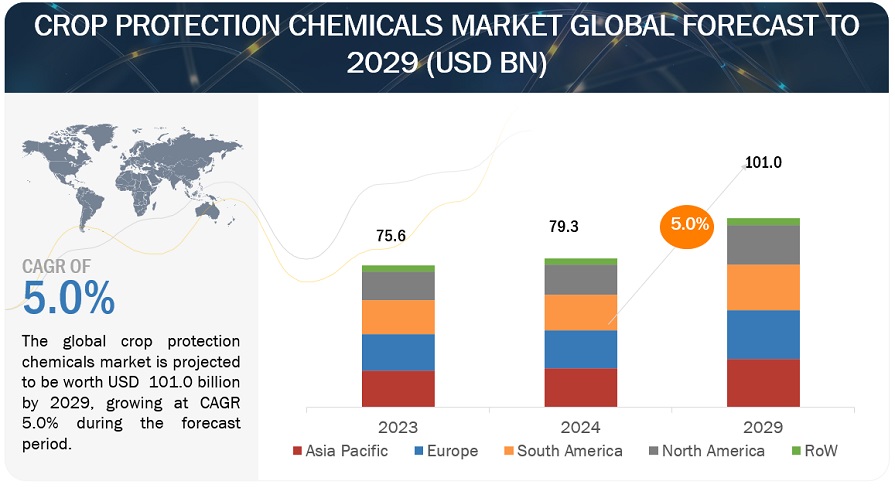The global crop protection chemicals market is estimated at USD 79.3 billion in 2024 and is projected to reach USD 101.0 billion by 2029, at a CAGR of 5.0% from 2024 to 2029. Crop protection encompasses practices and products aimed at safeguarding crop yields, including methods to improve yield and prevent losses from diseases, insects, fungi, rodents, and more. Farmers benefit from sustainable practices, increased yields, and better returns on investments. Protection can be implemented before, during, and after cultivation using fungicides, pesticides, herbicides, and biopesticides, along with methods like seed treatments, trap cropping, and biological control. The crop protection chemicals market is growing due to the increasing need to enhance agricultural productivity and ensure food security amidst challenges like pest infestations and crop diseases.

Download PDF Brochure: https://www.marketsandmarkets.com/pdfdownloadNew.asp?id=380
Crop Protection Chemicals Market Opportunities : Integrated pest management (IPM)
Integrated Pest Management (IPM) presents a substantial opportunity for the crop protection chemicals market by promoting a balanced and sustainable approach to pest control that incorporates chemical, biological, cultural, and physical methods. IPM strategies advocate for the judicious use of crop protection chemicals, applying them only when necessary and in combination with other control techniques to minimize environmental impact and prevent resistance build-up in pests. This approach encourages the development and use of more targeted, environmentally friendly chemical products that fit within IPM frameworks. Consequently, it opens avenues for innovation and growth in the market as companies develop new formulations and technologies that align with IPM principles, thereby catering to the increasing demand for sustainable and effective pest management solutions.
In the crop type segment, the cereals & grains segment holds the largest market share in the crop protection chemicals market.
Staple crops such as wheat, rice, corn, and barley are essential for human and livestock consumption, driving substantial demand for effective crop protection solutions to ensure their high yield and quality. These crops are particularly vulnerable to a wide range of pests, diseases, and weeds, necessitating the extensive use of herbicides, insecticides, and fungicides. Additionally, the large-scale cultivation and significant economic value of cereals and grains amplify the need for crop protection chemicals, as any potential yield loss directly impacts food supply chains and market stability. Consequently, the critical importance of safeguarding these staple crops solidifies the dominance of the cereals and grains segment within the crop protection chemicals market.
In the mode of application segment, the seed treatment segment is expected to grow at the highest CAGR during the forecast period.
Seed treatment involves applying crop protection chemicals directly to seeds before planting, aiming to protect them from pests, diseases, and other stressors during germination and early growth stages. This method offers several advantages, including efficient use of chemicals, targeted application, and minimal environmental impact compared to traditional spraying methods. The increasing adoption of precision agriculture and advancements in seed coating technologies contribute to the growing popularity of seed treatments. Moreover, seed treatment ensures uniform coverage and better efficacy, enhancing crop establishment and yield potential. As farmers seek cost-effective and sustainable solutions to maximize crop productivity, the seed treatment segment is expected to experience significant growth, driven by its effectiveness and compatibility with modern agricultural practices.
Make an Inquiry: https://www.marketsandmarkets.com/Enquiry_Before_BuyingNew.asp?id=380
The Asia Pacific region is expected to dominate the crop protection chemicals market during the forecast period.
This dominance arerapid growth is fueled by the region’s substantial agricultural base and the increasing need to enhance crop yields to feed a burgeoning population. Asia-Pacific accounts for over 60% of the world’s population, with countries like China and India leading in agricultural production. In these countries, agriculture contributes significantly to the GDP, necessitating efficient crop protection solutions to ensure food security and economic stability. The region faces severe pest and disease pressures due to diverse climatic conditions, further driving the demand for effective crop protection chemicals. For instance, the prevalence of falls like the Fall armyworm has led to substantial crop losses, prompting governments and farmers to invest in robust pest management solutions. The increasing adoption of modern farming practices and technologies in countries like Japan, Australia, and South Korea is boosting the market for advanced crop protection products. These advancements include precision agriculture, which optimizes the applicationreducesicwaste,ducingenhancesand enhancing effectiveness.


